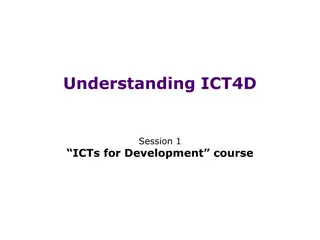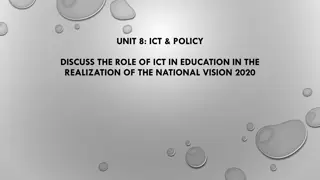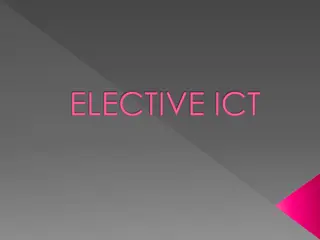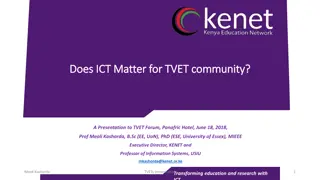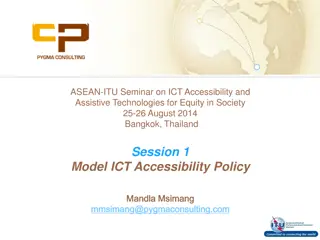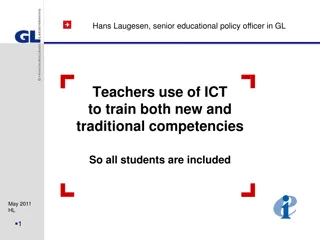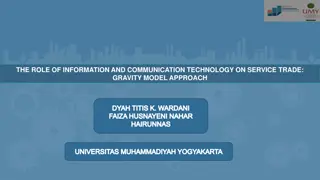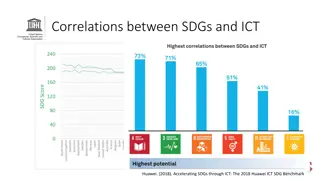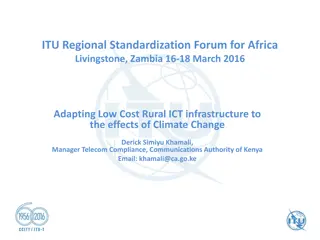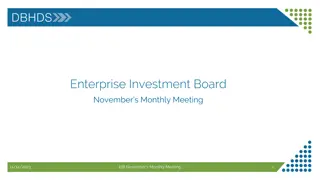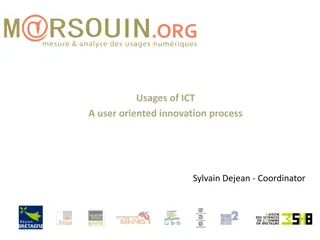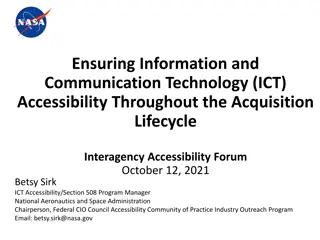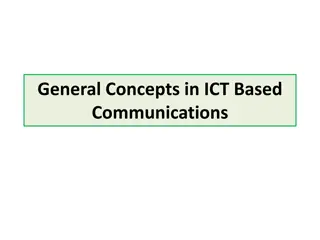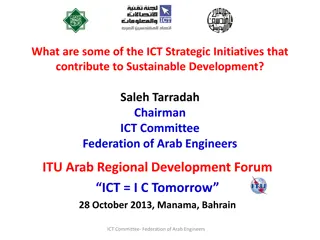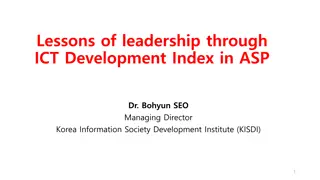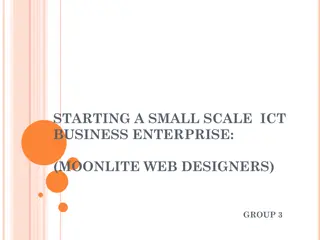Meeting the Demands of Modern Enterprise ICT Services
One of Europe's largest ICT service providers, T-Systems offers a wide range of IT, telecommunications, and integrated ICT services with extensive experience in managing complex outsourcing projects. With a global presence and cloud computing capabilities, T-Systems enables businesses to adapt to the dynamic market demands by providing scalable and efficient ICT resources that support collaboration, innovation, and competitiveness across various industries.
Download Presentation

Please find below an Image/Link to download the presentation.
The content on the website is provided AS IS for your information and personal use only. It may not be sold, licensed, or shared on other websites without obtaining consent from the author.If you encounter any issues during the download, it is possible that the publisher has removed the file from their server.
You are allowed to download the files provided on this website for personal or commercial use, subject to the condition that they are used lawfully. All files are the property of their respective owners.
The content on the website is provided AS IS for your information and personal use only. It may not be sold, licensed, or shared on other websites without obtaining consent from the author.
E N D
Presentation Transcript
It is one of the Europes largest ICT service providers It offers a wide range of IT, telecommunications and integrated ICT services It boasts extensive experiencing in managing complex outsourcing projects It has 75 data centers with over 50,000 servers and over 125 MIPS in Europe, Asia, America and Africa Cloud computing is an opportunity for T-Systems to leverage its established concept for services delivered from data centers It enables customers to use services and resources on demand
11.2 WHAT ENTERPRISES DEMAND OF CLOUD COMPUTING Whether operated in-house or by an external provider, ICT is driven by two key factors : Cost pressure and market pressure. Both of these call for increases in productivity Ref fig : 11.1
Todays market are increasingly dynamic Products and skills rapidly become obsolete, eroding competitiveness So business people need to find and implement new ideas at an ever faster pace The Internet offers the opportunity to implement new business models and integrate new stakeholders into processes. Example : automative industry(It integrates OEM s , suppliers, dealers, customers on shared internet platform Markets and Market participants are changing at an unpredicted pace At the same time markets become more flexible. This not only enables the enterprises to move into new lines of business with greater ease and speed, it also changes common market condition
Customers respond faster to changes in the supply of goods and services , market shares shift , some supply and- demand relationship vanish completely, and individual markets shrink or disappear Against this background companies not only need to scale up , but also scale down ICT resources Required to keep their technology up to date need to be quickly scaled up and scale down in line with changing requirements
Today , enterprise ICT and business processes are closely interdependent so that the line between processes and technology becoming blurred As a result , ICT is now a critical success factor: It significantly influences competitiveness and value creation The demands also increasing the teamwork and collaborations Solutions not only have to deliver speed plus ease of use , they also have to support simultaneous work on the same documents , team meetings with different continents, provide necessary infrastructure. That is no easy task in today s environment
Globalization opens up new markets with greater competitions Prices for goods and services (power, staff, raw materials) are rising So the market growth slowing or stagnating To meet these challenges, companies have to improve their cost structures Staff downsizing and divesment of loss making units are often preffered option However Replacing fixed cost with variable cost: this improves liquidity The resulting liquidity is used to increase equity, mitigating financial risk Today s business expect a great deal from their ICT. It is not only open up market opportunities , it also has to be secure and reliable This means that ICT and associated services have to deliver speed, flexibility, scalability, security, cost effectiveness and transparency
Expectations differ considerably, depends upon company size and industry For example, a pharmaceuticals multinational, midsize retailer and a startup will have very different ICT requirements, when it comes to certification They all face same challenges: The need to penetrate new markets To launch new services To supply sales models To make joint offerings with partners Dynamic ICT deliers tangible benefits 1) Standardization : can create flexibilty 2)Automation 3)Modularization 4)Integrated creation of ICT services
Standardization and automation greatly reduce production costs and increase the efficiency and flexibility of ICT Price: There is less scope for customization. Everyone with a personal e-mail account . services of this kind fulfill their purpose, but offer only very stripped down functionality are usually free of charge More sophisticated e-mail solutions are available via fee- based premium offerings Standards- based modularization enables new forms of customization However , the greater customization of the solutions delivered to business reduces efficiency for providers , thereby pushing up prices With the help of ICT, there is clear conflict between customization and cost
Modularization allows providers to pool resourses as the basis for delivering the relevant services It is essentially a set of standardized individual modules that can be combined. The resulting combinations give rise to sophisticated applications tailored to the needs of the specific company One of the great strength of modules is their reusability The more easily and flexibly such modules can be combined for potential benefits One Example of modularization in a different context is combining web services from various sources The benefit of modular services is that they can be flexibly combined, allowing standard offerings to be tailored to specific requirements
An integrated approach to creating ICT services by combining standardization , automation and modularization So it can deliver the desired services to the customer quickly and flexibly Outsourcing , enables businesses to play an active part in production , tailoring ICT services to their(customer) changing needs The technology that supports the business customer relationship must be based on standards
11.4.1 Quality(End-to-End SLAs) If consumer s Internet or ICT service are unavailable, or data access is slow , the consequences are rarely serious But in business, the non availability of service will affect the entire business (lacking of production or preventing orders from being processed) In such cases, quality is of the essence :- the user is aware of the performance of system as a whole , including network connectivity Cloud service providers have to offer end to-end availability , backed by clearly defined SLAs The specific requirements are determined by weighing up risk against cost The importance of a particular process and the corresponding IT solutions are assessed The findings are then compared with the service levels on offer As a rule, higher service levels come at a higher price The quality question is not about combining the highest service levels, but about selecting the right levels for each service
11.4.1 Compliance and Security Compliance and Security are increasingly important for cloud computing providers Surveys consistently point out the security is the greatest obstacle of cloud computing In a 2008 cio.com study, It decision- makers cited security and loss of control over data as the key drawback of cloud computing For Business looking to deploy a form of cloud computing , legal issues are considerably more important
Consumer Cloud versus Enterprise Cloud: The Internet has given rise to new forms of behaviour , when concluding contracts on-line When presented with general terms and conditions , many consumers simply check the relevant box and click OK , not realizing that they are entering into a legally binding agreement Cloud computing raises no legal issues, but it making existing ones more complex. The increased complexity is due to two factors: In a Cloud Computing, data no longer have to reside in a single location Business scenarios involving multiple partners are now conceivable It is therefore impossible to say exactly where data are stored and what national legislation applies. And whwre data are handled by multiple providers from different countries, the issue of liability becomes complex
Cloud Computing from an Enterprise perspective : With this in mind, businesses should insists on comprehensive, watertight contracts that include provisions for recovery and return of their data , even in the event of bankruptcy They should establish the country where servers and storage systems are located Cloud principles notwithstanding services still have to be performed and data stored at specific physical locations Where data are located determines whose law applies and also determines which government agencies can access it. And also enterprises have to consider that data privacy cultures differ from country to country Having the legal basis for liability claims is one thing. Successfully prosecuting them is quite another Companies listed on the U.S stock exchange are subject to the Sarbanes- Oxley Act(SOX) , requiring complete data transparency and audit trails. This poses particular challenges for cloud providers To comply with SOX 404, CEOs , CFOs, and external auditors have to report annually on the adequacy of internal control systems for financial reporting Cont.. Cont..
ICT service providers are responsible for demonstrating the transparency of financial transactions Service providers also have to ensure that are not lost and do not fall into the wrong hands The EU has data-security regulations that apply for all European companies Moreover , some industries and markets have their own statutory requirements It is therefore essential that customers discuss their specific needs with the provider. And the provider should be familiar with industry-specific practices and acquire appropriate certification Providers also have to safeguard data against loss, and business that use cloud services should seek a detailed breakdown of disaster recovery and business continuity plans Other legal issues may arise directly from the technology behind cloud computing
What Enterprises Need : Cloud Computing and applicable ICT legislation are based on diametrically opposed principles The former is founded on liberalism and unfettered development in the case of technical opportunities The latter imposes tight constraints on the handling of data and services , as well as on the relationship between customers and providers These two perspectives will be reconciled in the near feature Cloud providers have to meet the requirements of the law and of customers alike Providers working for major corporations have to be dependable in the long term, particularly where they deliver made-to-measure solutions for paarticular business process Before selecting a cloud provider , customers should take a long hard look at candidate s services , ability to deliver on promises , and above all , how well SLAs meet their needs
11.5.1 Flexibility across all modules : Agility at the infrastructure level alone is not enough to provide fast, flexible ICT services Other Dynamic levels and layers are also required Ref . fig. 11.2 Adaptable processing and storage resources at the computing level must be supported by agile LAN and WAN infrastructures Flexibility is also important when it comes to application delivery, scalability, and extensibility via functional modules Management processes must allow for manual intervention ,where necessary , and automatically link with various layers. These factors enable the creation of end-to- end SLA across all components Every Dynamic ICT service is based on a resource pool from which computing, data, and storage services can be delivered as required Dynamic network and application services are also available . The applications are optimized for deployment with pooled resouces When customer opt for a dynamic service, they require an SLA that covers not only individual components , but also the service as a whole , including any WAN elements Cont.. Cont..
Toward Dynamic, Flexible ICT Services: Step1: Standardize To standardize the Customer s existing environment . It systems running different software releases have to be migrated , often to a single operating system . Hardware also has to be standardized Eliminating disparate operating system and hardware platforms for easy automation Step2: Technical Consolidation It reduces physical servers and also slim down data storage Identical backup and restore mechanisms are introduced at this stage small and uneconomical centers are closed Step 3: Virtualization It means that services no longer depend on specific hardware It enables server resources to be subdivided and allocated to different tasks Cont.. Cont..
Step 4: Automation It slashes costs, improve efficiency and accelerates standard procedures In the business world , automation must also support seamless integration of financial , accounting and ordering systems Cont.. Cont..
11.5.2: T-Systems Core cloud modules : Computing , storage Computing : The Computing pool is based on server farms located in different data centers The logical server systems are created automatically at these farms The server systems comply with predefined standards They are equipped with the network interface cards required for communication and integration with storage systems No internal hard drives or direct attached storage systems are deployed The configuration management database(CMDB) plays a key role in computing resource pools (Ref : Fig. 11.3) 1.This selects and configures the required physical server 2.Once a server has been selected from the pool , virtualization technology is selected in line with the relevant application and the demand it has to meet 3. The configuration requirements are sent to the network configuration management system 4. It also sent to the storage configuration management system 5. Once all the necessary elements are in place, the storage systems are mounted on the servers, after which the operating system images are booted The configuration database must be updated automatically to accurately reflect the current state of systems and configurations at all times Cont.. Cont..
The CMDB also supports other tasks. These include enhanced monitoring and reporting Quality management Resource Planning Applications are also virtualized Speed is one of the essence of cloud computing providers Decoupling operating systems from applications plays a key role ,because it reduces both initial and subsequent application provisioning time Applications can quickly be moved from one server to another , and updates can be managed independently of operating systems The full benefits can only be realized if there is a high degree of automation and standardization in the IT infrastructure and application themselves Cont.. Cont..
Storage : IP based storage systems are deployed . To reduce hardware configuration effort , the computing systems use neither SAN or direct attached storage Using Fiber Channel(FC) cards in the servers and deploying an FC Network increases overall system complexity substantially The IP storage systems are linked via Gbit Ethernet Storage is automatically allocated to the server systems that require it Storage resources are located in different zones as well as different data centers for preventing data loss in the event of a disaster The Storage system handles replication of data between data centers and fire zones So computing resources not needed for this purpose Cont.. Cont..
Ref . Fig. 11.4 Backup- integrated storage(BIS): Backups are necessary to safeguard against data loss Backup- integrated storage(BIS) is provided , along with full management functionality To accelerate backup and reduce the volume of the data transferred , data are backed up on hard disks within the storage system in the forms of snapshotting This simplifies the structure of the computing systems and minimizes the potential for temporal bottlenecks Storage system normally provide 35-day storage period Archive and other storage : Archive systems are also available for long term data storage Like BIS the Systems are hard disk based and linked via IP Data for archiving is replicated within the archive system in a separate separate fire zone as well as at remote data center Replication is handled by the archive system itself Archive storage can be managed by two ways : 1. It can be initiated from application themselves 2. Document management System Some systems require a hard disk cache Cont.. Cont..
Communications : The computing and storage modules are integrated via an automatically configured LAN or corresponding Virtual Private Networks(VPN) The servers used in the computing module are equipped with multiple network cards as standard Depending on requirements , these are grouped to form the necessary networks Networks are segregated from each other by VPN technology BIS elimiates the need for a separate backup network Customer Network Access for customers is provided via Internet /VPN connections Services are assigned to companies by unique IP address Access to dynamic data centers is protected via redundant, clustered firewalls Virtual firewalls are configured automatically Access is entirely IP based Storage and Administration Network A separate storage network is provided for accessing operating system images , applications, customer and archive data Configuration is handled automatically Cont.. Cont..
11.5.3 Dynamic Services 11.5.3 Dynamic Services A Brief Overview A Brief Overview The Dynamic Data center concept underlies all T-Systems Dynamic services All the resources required by a given service are automatically provided by the data center Dynamic Applications for Enterprise: T-Systems has tailored its portfolio to fulfill these requirements: Communication and Collaboration : These are the key components for any company. Work on projects often entails frequent changes in user numbers. As a result , enterprises need flexiblility for handling communications and collaboration ERP and CRM Development and Testing Middleware Front-Ends and Devices Introducing New Services in a Dynamic Data Center: The providers of cloud computing have to continuously review and extend their offerings There is a standardized approach is key to ensuring that the services delivered meet business customer s requirements First, automatic mechanisms have to be developed for standardizing the installation of typical combinations of operating system, database , and application software These mechanisms must also support automated procedures for starting and stopping applications Cont.. Cont..
o The software components and their automatic management functions are subject to release and patch management procedures agreed with the vendors o An operating manual is developed and its recommendations tested in a pilot installation before the production environment goes live o Next, a variety of quality options are developed.These can include redundant resources across multiple fire zones o A concept of segregatting applications from each other is also created Cont.. Cont..
11.5.4 Dynamic Data Centers across the Globe 11.5.4 Dynamic Data Centers across the Globe T-Systems delivers Dynamic services from multiple data centers around the world. (Ref. Fig. 11.5) These are mostly designed as twin-core facilities All Dynamic Data centers are based on the original concept used for the first data center of this kind in frankfurt These are currently facilities in the United States , Brazil, Germany,Singapore and Malasiya



